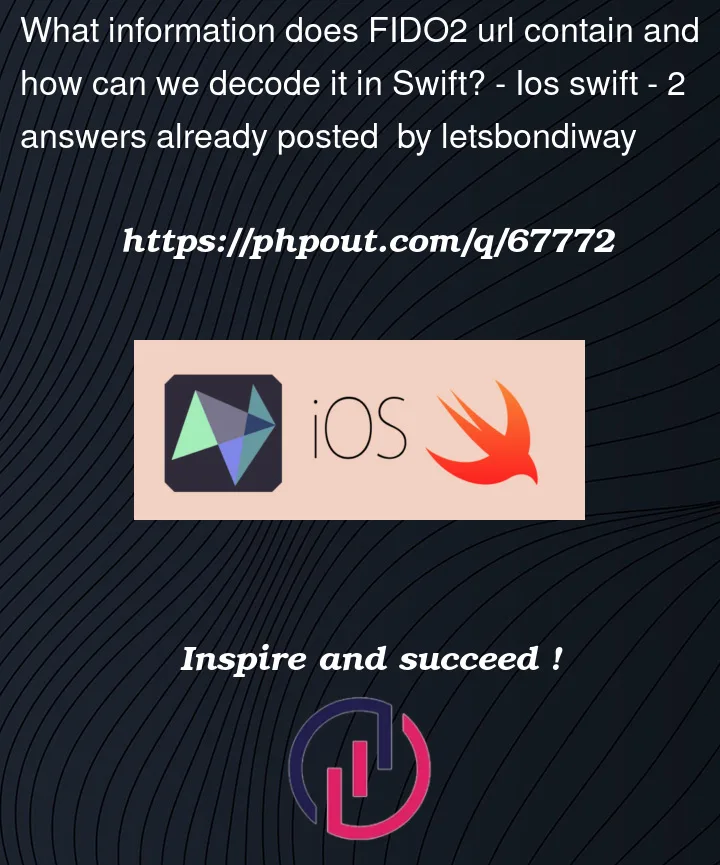In WWDC 2022 Apple launched GA for Passkeys which will enable in FIDO2 authentication, the next gen open standards based authentication mechanism to replace passwords.
On a Relying Party (RP) server supporting FIDO2 when a user registration is initiated, the browser generates a QR code to register a phone as platform authenticator.
I am trying to build an app which opens up a QR scanner view and I want to register for the FIDO credential by scanning the QR code generated by the browser. The parsed string is of the format – FIDO:/090409094349049349…….
What information does this FIDO:/090409094349049349……. url protocol contain relating to the RP? Also, is there a way to decode this in Swift to get that information in json or string format?
Since the camera app on iPhone is able to scan the QR and generate information like RP domain name and user being registered, I believe there should be a way to do this from a QR scanner inside an app as well. Or are these APIs private in nature only for usage of Camera app?




2
Answers
This is a FIDO protocol that is implemented as a system service/function and would not be useful to your app.
This is a Client Authenticator Protocol (CTAP) v2.2 hybrid flow link which is meant to bootstrap a Bluetooth connection between the device
reading the QR code and the host computer which shows it. This has formerly been known as "cloud assisted bluetooth low energy"
binding, or
cablein short.To decode one of these, lets take an example I created from the webauthn demo page [DEMO] when clicking on
Register.The
FIDO:/URI-scheme is registered with IANA at [IANA].Next comes a base10-encoded string, which means that 7 bytes get encoded into 17 digits. It can be decoded for
instance with
This yields the byte string
which is in fact a CBOR [CBOR, CBOR2] value that looks like
To understand this map, we need to know the significance of the map keys, for which I couldn’t obtain a normative source.
Thus, the truth lies in the code [CHROME].
Key
0contains the compressed public key [BTC] of the relying party, in our casehttps://webauthn.io.Key
1contains the shared secret with which the device will proof that it read the QR code.Key
2contains the number of registered tunnel server domains.Key
3is the host unix time upon creation of the request, in our case Mon Mar 06 2023 14:41:18 GMT+0000Key
4tells us if the host computer showing the QR code supports device linking.Key
5is the request type of the operation, in this casemcwhich stands for Make Credential, i.e. we want to perform a device registration.Note that this parameter is just a hint to the mobile device and not strictly necessary, as the QR code itself doesn’t perform any Webauthn/CTAP operation,
it merely helps to avoid the Bluetooth Pairing of the two devices.
Key
6declares that the call should be non-discoverable.Further reading for WebAuthn [WEBAUTHN] and Client to Authenticator Protocol [CTAP].
—
[IANA] https://www.iana.org/assignments/uri-schemes/prov/fido
[DEMO] https://webauthn.io/
[CHROME] https://github.com/chromium/chromium/blob/50479218fc94681552b7ba2c526069141182a143/device/fido/cable/v2_handshake.cc#L441-L469 and https://github.com/chromium/chromium/blob/50479218fc94681552b7ba2c526069141182a143/device/fido/cable/v2_handshake.h#L107-L127
[CBOR] https://www.rfc-editor.org/rfc/rfc8949.txt
[CBOR2] https://cbor.me/
[CTAP] https://fidoalliance.org/specs/fido-v2.1-ps-20210615/fido-client-to-authenticator-protocol-v2.1-ps-errata-20220621.html Note that this is only version 2.1. Our QR code will only
be specified in version 2.2 which is unfortunately not yet publicly available.
[WEBAUTHN] https://www.w3.org/TR/webauthn-2/
[BTC] https://btcinformation.org/en/developer-guide#public-key-formats